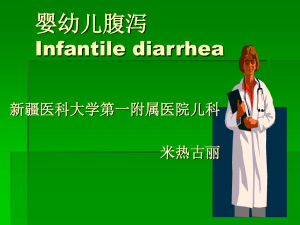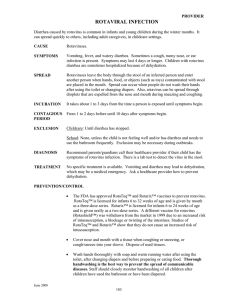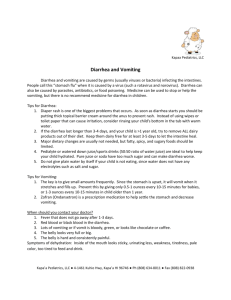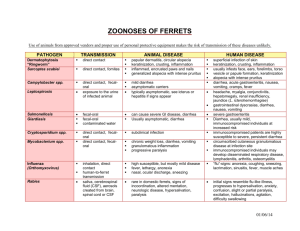licensed under a . Your use of this Creative Commons Attribution-NonCommercial-ShareAlike License
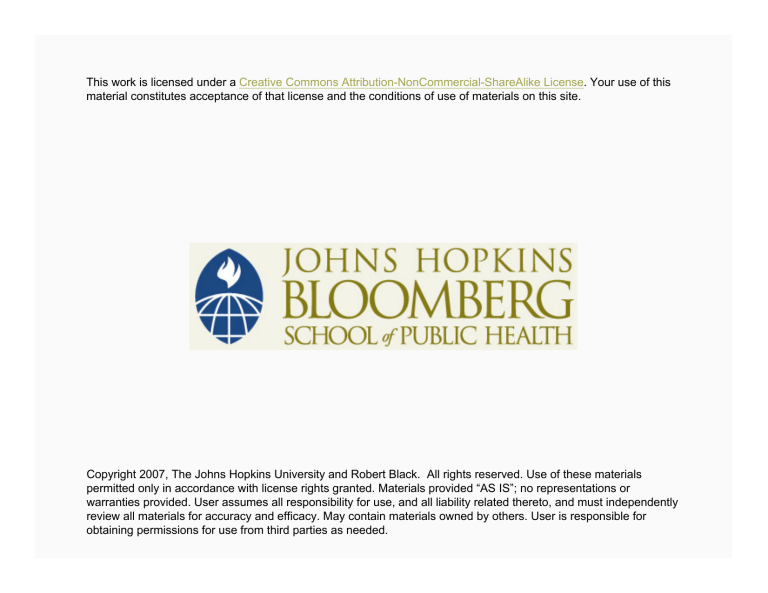
This work is licensed under a Creative Commons Attribution-NonCommercial-ShareAlike License . Your use of this material constitutes acceptance of that license and the conditions of use of materials on this site.
Copyright 2007, The Johns Hopkins University and Robert Black. All rights reserved. Use of these materials permitted only in accordance with license rights granted. Materials provided “AS IS”; no representations or warranties provided. User assumes all responsibility for use, and all liability related thereto, and must independently review all materials for accuracy and efficacy. May contain materials owned by others. User is responsible for obtaining permissions for use from third parties as needed.
Epidemiology of Diarrheal Diseases
Robert Black, MD, MPH
Johns Hopkins University
Robert Black, MD, MPH
Chairman, Department of
International Health
Researches the interaction of infectious diseases and nutrition
Engaged in randomized trials and effectiveness evaluations of vaccines for rotavirus, Hemophilus influenzae type B, pneumococcal, and shigella
Assesses nutritional interventions to reduce infectious disease morbidity and mortality
3
Overview
The pathophysiology of the major causes of childhood infectious diarrhea
The importance of diarrhea in children globally and the associated pathogens
Risk factors and transmission patterns for diarrhea and related preventive interventions
4
Section A
Definition of Diarrhea and Pathophysiology
What Is Diarrhea?
Stools of decreased consistency and increased volume due to imbalance of secretion and absorption of water and salts in the intestine
6
Types of Diarrhea in Developing Countries
Noninfectious (infrequent), e.g., congenital, inflammatory bowel disease
Infectious (predominant), e.g., bacterial, viral, parasitic
7
Pathophysiology of Infectious Diarrhea
Secretory (noninflammatory), i.e., toxin stimulates chloride secretion and reduces absorption of sodium and water (e.g.,
V. cholerae or organism reduces small bowel absorptive villus structure and function (e.g., rotavirus)
Invasive (inflammatory), i.e., organism penetrates and damages cells of intestinal mucosa (e.g., shigella)
8
Virulence Factors of Enterotoxigenic Coli
9
Enterotoxigenic E. coli Infection
10
Rotavirus Infection
11
Shigella Infection
12
Section B
Importance Globally and Associated Pathogens
Annual Under-Five Mortality in Developing Countries
Annual mortality from diarrhea in children less than five years old in developing countries
−
1.8 million deaths
−
Decreased from 4.5 million deaths in last 20 years
14
Annual Under-Five Episodes in Developing Countries
Annual incidence of diarrheal disease episodes in children less than five years old in developing countries
−
Median incidence rate 3.2 episodes per child
−
Two billion diarrheal episodes globally
15
Effect of Gender on Diarrhea Incidence
Male-to-female ratio
−
Community-based studies = 1.2
−
−
Hospital-based studies = 1.4
Demographic and health surveys = 1.0
Some countries (e.g., in South Asia) have greater care seeking for boys
16
Age-Specific Incidence of Diarrhea in Bangladesh
17
Identified Enteropathogens: 61 Community-Based Studies
Percentage of identification of selected enteropathogens from children with diarrhea in 61 community-based studies
Enteropathogen
Enterotoxigenic E. coli
Enteropathogenic E. coli
Rotavirus
Campylobacter
Cryptosporidium
Shigella
Percentage
14
9
6
5
8
8
18
Identified Enteropathogens: 107 Facility-Based Studies
Percentage identification of selected enteropathogens from children with diarrhea in 107 health facility-based studies
Enteropathogen
Rotavirus
Enteropathogenic E. coli
Enterotoxigenic E. coli
Shigella
Campylobacter
Salmonella
Percentage
25
16
5
4
10
6
19
Dehydrated Under-Fives with Diarrhea: Bangladesh
Percentage of children less than five years old experiencing dehydration during diarrheal episodes, by enteropathogen, in community-based studies in rural Bangladesh
Enteropathogen No. of episodes
78
No. with dehydration
28 Rotavirus
Enterotoxigenic
E. coli
Other
322
843
17
17
Percentage with dehydration
36
5
2
20
Viral Agents: Developing Countries Compared to U.S.
Comparison of viral etiologic agents of diarrhea in developing countries and the United States
Etiologic agent
Rotavirus
Noroviruses
Enteric adenoviruses
Developing country
Important
Probably important
Minor
U.S.
Very important
Important
Probably important
21
Bacterial Agents: Developing Countries Compared to U.S.
Comparison of bacterial etiologic agents of diarrhea in developing countries and the United States
Etiologic agent
Enterotox.
E. Coli
Campylobacter
Developing country
Very important
Important
U.S.
Minor
Important
Shigella
Salmonella
Enterohem.
E. Coli
Important
Variable
Minor
Minor
Important
Important
22
Parasitic Agents: Developing Countries Compared to U.S.
Comparison of parasitic etiologic agents of diarrhea in developing countries and the United States
Etiologic agent
Cryptosporidium
Giardia
Strongyloides
E. histolytica
Developing country
Important
Minor
Minor
Minor
U.S.
Minor
Minor
Minor
Minor
23
Section C
Risk Factors, Transmission, and Prevention in Developing
Countries
Seasonality in Developing Countries
Bacterial diarrheas usually peak in hot months
Viral diarrheas may have some peak in cooler months, but transmission continues year round
25
Seasonality of Diarrhea in Lesotho
26
Seasonality of Diarrhea in Bangladesh
Matlab Treatment Center Visits for Diarrhea Associated with Enterotoxigenic Escherichia coli, Vibrio cholerae, and
Rotavirus, February 1977–January 1979
27
Co-infection
Percentage of diarrhea cases with co-infection (i.e., two or more enteric pathogens)
−
Community-based studies: 11%
−
Hospital-based studies: 12%
28
Symptomatic, Asymptomatic C. jejuni Infections, Mexico
Incidence of Campylobacter Infections at Increasing Age Groups, in a Cohort of 179 Mexican Children
29
Transmission of Infectious Agents Causing Diarrhea
“Fecal–oral” via
−
Food
−
−
Water
Hands
30
Infectious Dose Affects Transmission
Low infectious dose (e.g., shigella, giardia, rotavirus, cryptosporidium) can be transmitted by person-to-person contact
High infectious dose (e.g., salmonella, E. coli, vibrios) usually transmitted by water or food
31
Preventive Interventions for Diarrhea Mortality
Breastfeeding and complementary feeding
Improving food safety, water, sanitation, and hygiene
Vitamin A
Zinc
Measles immunization
Future—specific vaccines, e.g., for rotavirus, ETEC
(enterotoxigenic Escherichia coli ), shigella
32
Risk Factors for Childhood Diarrhea
Suboptimal breastfeeding
Contaminated complementary foods
Poor quality of water
Poor sanitation and hygiene
Malnutrition and micronutrient deficiencies
− vitamin A deficiency
− zinc deficiency
33
Prevention of Childhood Diarrhea
Breastfeeding
Safe complementary feeding
Latrines and hand washing
Water supply and quality
34
Prevention of Childhood Diarrhea
Correcting Vitamin A deficiency—reduces mortality, but not incidence
Correcting zinc deficiency—reduces mortality and incidence
Preventing stunting—reduces mortality and incidence
35
